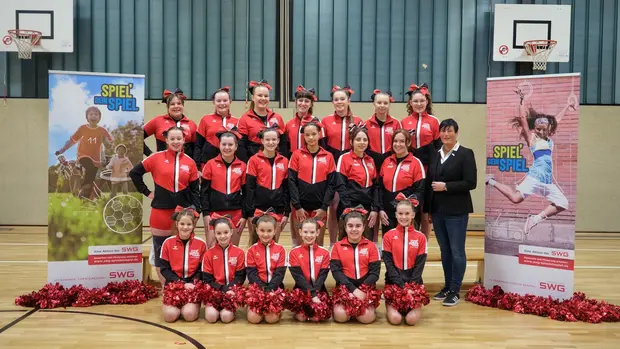
Stadtwerke Gießen is supporting the Wild Fire Cheer from Grünberg as part of its "Play your game" campaign.
Leading the applause - this literal translation of cheerleading doesn't just sound wooden. It is also misleading, as it only describes one facet of a very attractive sport. Cheerleading is much more than just jumping around with pompoms on the sidelines. It combines elements of dance, floor gymnastics and acrobatics to create an independent team sport in which competitions are held. The Wild Fire cheerleaders from Grünberg will be taking part in one such competition this weekend. The 17 girls aged between ten and 17 will be taking part in the German All Level Championship West in Düsseldorf for the first time. At this event from a series of championships with international participation, the young Grünberg ladies can be recognised from the outset as a sworn squad - that's what cheerleading teams are called. This is because they are travelling with new jackets from Stadtwerke Gießen (SWG). "We're twice as happy," explains Nadja Kolodziej, coach of the Wild Fire cheerleaders. "About the fact that our application for the "Spiel' Dein Spiel" campaign was successful. And that we received the jackets in time for our first competition."
Support for the Bender Baskets
Unlike most other sports, cheerleading is not primarily about competing against others. In American team sports - especially football and basketball - cheerleaders provide entertainment during breaks in play, cheer on the teams on the field and encourage the audience to do the same. The Wild Fire cheerleaders take on this task for the Bender Baskets Grünberg. Which is hardly surprising. Like the women's Bundesliga team, the cheerleaders also belong to TSV 1883 Grünberg e. V. The special thing about the Wild Fire Cheer: the squad would also be willing to serve other teams from the region and bring joy to their spectators. For one very simple reason: "We want to use every opportunity to show others how much fun we have with our hobby," explains Nadja Kolodziej. Consequently, they also perform at public and private events that basically have nothing to do with sport.
No pain, no gain
What looks playful and easy to the public requires a lot of practice and hard training. The Wild Fire cheerleaders meet three times a week to hone their performances under the guidance of coaches Nadja Kolodziej and Lara Spissinger. Among other things, this involves executing complex choreographies with fast step sequences and effective arm and body movements as synchronised as possible. "Dance is an essential part of our sport, but of course acrobatics also make up a considerable part of the training," summarises Nadja Kolodziej. Cheerleaders actually perform so-called stunts, which have to be practised meticulously: they build human pyramids or throw athletes up into the air and catch them again. There is also tumbling. These are acrobatic elements from floor gymnastics - such as cartwheels, flickflacks or somersaults. The repertoire also includes lots of different jumps. "Because we support the Bender Baskets as a sponsor, we have of course often seen the Wild Fire cheerleaders in action," explains Stephanie Orlik. She is in charge of the "Spiel' Dein Spiel" campaign at SWG and adds: "It's really nice to see what has been created here over the past 24 years. And we are delighted to now be able to help the cheerleaders a little with the further development of their beautiful sport in Grünberg."
Many positive effects
To be successful, cheerleaders have to work together perfectly. To do this, they first need to be willing to fit in with the group. Cheerleading therefore promotes the ability to subordinate oneself to the team and play one's part. In addition, the acrobatic component in particular develops two other important social skills in young people: Depending on which tasks they fulfil in the squad, cheerleaders take responsibility for their teammates or trust them blindly. Anyone who throws someone into the air must ensure that the person is caught again and lands safely. And anyone flying through the air - whether after a fall from the top of a pyramid or after a throw - must be able to rely on the catchers to do their job reliably.
In addition to the psychological aspect, cheerleading also places certain demands on various physical and coordination skills. Or in short: fitness. At the forefront of this is, of course, the coordination that is absolutely essential for the dance - especially the ability to rhythmise. Stamina also plays a certain role. After all, a competition choreography requires 2:30 minutes of full power. Strength and flexibility are also necessary. Anyone who forms the stable base in a pyramid or lifts someone must be strong enough to do so. And those who stand at the top or fly through the air from time to time need good flexibility. Consequently, regular cheerleading promotes all of these skills and competences. "Cheerleading is more than just a sport. Cheerleading is about team spirit and discipline, pushing your limits and surpassing yourself. And learning for life," says Nadja Kolodziej. And Stephanie Orlik adds: "In the "Spiel' Dein Spiel" jury, we have learnt to always take a close look. Because it's often not obvious at first glance how much good the different sports do. Cheerleading is a great example of this."

